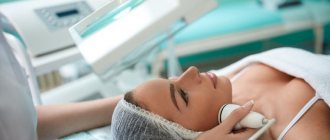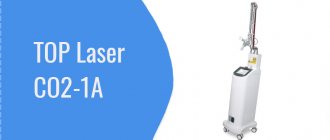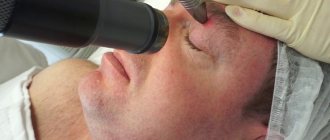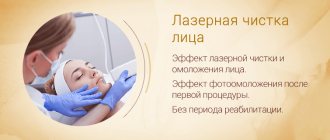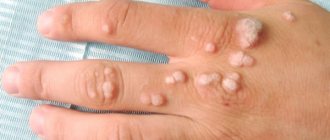Laser peeling (or laser resurfacing) is a procedure for cleansing and rejuvenating the skin using laser radiation. Laser peeling effectively fights dead epidermal cells, removes skin defects in the form of post-acne scars, and also accelerates cellular regeneration of the skin. The advantage of laser peeling is its absolute safety, control of the depth, frequency and duration of beam penetration.
Main article: Fractional photothermolysis >>>
Fractional rejuvenation >>>
Laser skin resurfacing >>>
You can also read our other articles describing the use of fractional laser:
- laser resurfacing of stretch marks on the skin >>>;
- laser resurfacing of scars on the body >>>;
- laser resurfacing of facial scars >>>;
- laser resurfacing of the lower eyelid >>>;
- laser resurfacing of skin and pores >>>.
Why is laser peeling performed?
The essence of the laser peeling procedure is that the laser “evaporates” the top layer of the epithelium, after which the active mechanism of regeneration of new layers is launched. The skin independently begins to produce new collagen, which is responsible for how our skin looks and how elastic and firm it is. The main advantage of laser peeling is the precise dosage of exposure and the depth of penetration of the beam, which allows you to avoid damaging the skin. Other types of peeling cannot provide such precision.
photo after laser facial peeling
Why should you use laser peeling?
- correction of age-related changes. Laser resurfacing perfectly combats photoaging of the skin. As a result of exposure to ultraviolet radiation on the skin, fibrous tissue grows and fluid decreases, which contributes to the appearance of fine wrinkles and a decrease in skin elasticity.
- reduction of scars and scars. The main indication for resurfacing is the presence of scars. A scar is connective tissue formed after wounds and burns. Connective tissue forms its own layer between the edges of the wound, resulting in a scar. Laser resurfacing with each procedure removes connective tissue and causes healthy cells nearby to “divide.”
- elimination of post-acne scars. Due to laser exposure to the skin and removal of the upper layers, and then regeneration, the skin is renewed. The connective tissue of scars decreases, their depth decreases, as a result of which the structure of the skin improves. Resurfacing post-acne scars is not painful, since there are no nerve endings in the upper layers of the skin. After the laser, the skin cools quickly.
- elimination of pigment spots. Laser resurfacing can also remove age spots. The principle is the same as for polishing scars. The top layer of skin is removed, regeneration starts and new healthy skin is formed.
- Find out the current offers
- Sign up for a consultation
Online registration
What are the benefits of laser peeling?
Laser resurfacing has a number of advantages over other resurfacing procedures, namely:
- control of beam penetration depth and pulse intensity;
- the ability to use the method in a fairly deep range - from simple skin cleansing to removing scars.
photos before and after laser facial peeling
How long does it take for skin to recover after laser peeling?
If you strictly follow the doctor's instructions, the rehabilitation period can be reduced to a minimum. The “new” skin is still thin and unprotected, so we advise all our patients to use sunscreen with a high protection factor of 50+, regardless of the weather. Also, after the laser peeling procedure, doctors advise performing mesotherapy or biorevitalization so that the skin can recover faster.
laser facial peeling: photos before and after the procedure
Advantages of laser resurfacing:
- This procedure is suitable for any age
- Does not pose a risk of infection
- Effectively rejuvenates the skin and improves its structure
- Leads to smaller pores
- Skin heals quickly after laser resurfacing
- No thermal damage
- No transition boundaries are visible on any part of the skin
- Erbium laser can eliminate previous cosmetic imperfections
- Removes dangerous epidermal cells
- Affordable price
- Suitable for men and women
How it goes
- The fractional laser peeling procedure is performed using an anesthetic cream.
- After a preliminary conversation with the patient about existing problems and studying the characteristics of his skin, the doctor performs makeup removal.
- An anesthetic is applied to cleansed skin and left for 40-60 minutes.
- The patient protects his eyes with glasses.
- The doctor selects the laser exposure parameters, removes the anesthetic, applies a lubricating cream and begins Fraxel peeling.
- When the manipulator touches the skin, fractional destruction of defective cells occurs, the patient feels warmth and a slight burning sensation.
- Facial treatment lasts on average 20-30 minutes.
- 20-30% of the skin surface is treated in one session
Fractional procedures
Before the invention of fractional treatments, there were two main laser rejuvenation technologies. The first technology is ablative, planar grinding to the basement membrane. The result from such a one-time procedure was simply stunning, but the recovery time was about two weeks. There were few people willing to sit at home for two weeks.
The second technology is the complete opposite of the first. A neodymium (ND:YAG) laser was used, which, over the course of procedures, “slowly and sadly” stimulated neocollagenogenesis. The recovery period was zero, but the effect grew so slowly that the patient refused to believe in the effectiveness of the procedure.
Fractional procedures were supposed to combine the advantages of both procedures, to become a kind of final solution, a panacea. Of course, there is no panacea, and fractional procedures have firmly occupied an intermediate position between planar (non-fractional) ablative and non-ablative procedures.
Fractional procedures are also non-ablative (coagulation), ablative, and mixed - ablative-coagulation.
Fractional coagulation laser forms columns of coagulated tissue in the dermis without damaging the epidermis. Depending on the approach, this can be considered both an advantage and a disadvantage. The most typical representative of such lasers is the Fraxel re:store, an erbium fiber laser with a wavelength of 1550 nm.
It is very important not to confuse the two erbium - ER:YAG with a wavelength of 2940 nm and erbium (also) lasers with a wavelength of 1540-1550 nm.
ER:YAG with a wavelength of 2940 nm is “tuned” to the strongest absorption in water to achieve maximum ablative effect.
For erbium lasers with a length of 1540-1550 nm, the “tuning is off,” on purpose. The absorption of the laser beam by water for such lasers is lower than not only for ER:YAG, but also for CO2. The beam of such a laser, without causing ablation, penetrates tissue to a depth of about a millimeter. As it penetrates, the radiation causes heating and coagulation of tissues.
Structurally, lasers differ in the composition of the working fluid – crystal or fiber. In ER:YAG, erbium atoms (ER) are introduced into yttrium aluminum garnet (YAG). In lasers with a wavelength of 1540-1550 nm, atoms of the same erbium are introduced into a glass rod or fiber.
A typical representative of the ablative-coagulation laser is CO2. In a fractional procedure, a laser beam creates a micro-hole surrounded by a well of coagulated tissue. It will not be possible to avoid coagulation, regardless of the pulse duration, because coagulation is formed due to radiation not well absorbed by water.
A fractional erbium ER:YAG laser can form a significantly smaller coagulation zone. When using high energy and short pulse duration, the coagulation zone is practically absent. The fractional ablative mode can, in particular, be used to deliver various drugs beyond the basement membrane, “laser mesotherapy.”
Increasing the pulse duration of the erbium ER:YAG laser allows the formation and expansion of the coagulation zone due to heat transfer during the pulse. Thus, the erbium ER:YAG laser can operate both in ablative mode (exclusively) and in ablative-coagulation mode (like CO2).
Fotona erbium ER:YAG lasers with Smooth technology can, in addition, operate in fractional non-ablative coagulation mode. Thus, Fotona erbium ER:YAG lasers with Smooth technology can operate in any of the fractional modes.
Indications
Fractional facial peeling is a soft and delicate skin cleansing procedure recommended for those over 25 years of age with the following indications:
- The first mild signs of photo or chronoaging.
- Initial weakening of skin tone.
- Pigment spots (freckles, melasma).
- dull skin color.
- Uneven microrelief of the skin (shallow scars, post-acne).
- Primary signs of rosacea.
- Enlarged pores, increased oil content.
Erbium laser in non-ablative mode
The Fotona Smooth erbium laser technology fully meets these requirements. The use of an erbium laser in a non-ablative mode, without perforation of the vaginal wall, completely avoids the risk of complications. Non-ablative thermal mode, designed to indirectly heat tissue through diffusion. Unfortunately, the same cannot be said about alternative techniques that use fractional perforation of the mucosa. Perforation of the mucous membrane can be performed using either a CO2 laser or ER:YAG lasers, whose manufacturers cannot use the patent-protected Fotona Smooth technology.
The experience of successful use (10 years) of an erbium laser in a non-ablative mode with Smooth technology on mucous membranes in gynecology has made it possible to develop methods for use in other areas of aesthetic medicine. Currently, the Fotona Smooth technique is successfully used when working on the mucous membrane of the eyelids, intraorally as a stage of the popular Fotona 4D express laser skin rejuvenation procedure, which does not require a recovery period or laser treatment procedures for snoring.
Contraindications to laser facial rejuvenation
The main contraindications for facial rejuvenation with laser equipment:
- Lactation period;
- Pregnancy;
- Malignant tumors;
- Chronic inflammatory processes;
- Herpes in the active stage;
- Poor blood clotting;
- Epilepsy attacks;
- Violation of the integrity of the skin in the projection of work;
- Mental disorders;
- Tan acquired less than 14 days ago;
- Immunodeficiency syndrome.
You can find out how pressing a problem for a patient can interfere with the laser procedure at an initial appointment at a cosmetology center.
The specialist will tell you about the risks or immediately offer an alternative, which includes facial contouring.
Erbium laser with Smooth technology
Erbium laser, especially with Smooth technology, is much better suited for affecting the skin. You can perform the Smooth laser rejuvenation procedure, including intraorally, and finish the procedure by polishing the epidermis. However, it should be noted that with such a two-step procedure, only some layers of tissue are exposed. Therefore, to achieve a better effect of skin rejuvenation, the procedure should be supplemented with other techniques. Such techniques can be used ND:YAG laser (preferably) or, for example, HIFU.
Erbium laser from Fotona is effectively used in cosmetology and gynecology. It has also shown its high effectiveness in the treatment of hair diseases (alopecia) and the treatment of snoring.
Do you want to buy an erbium laser and get more detailed information on Fotona laser equipment, the procedures that can be performed on it and the price of lasers? Call the single telephone number in Moscow and St. Petersburg 8 800 222 97 79 or write to us via the FEEDBACK FORM.
When purchasing a laser, we offer free post-sale training for doctors in your clinic, service and a warranty on laser devices from 3 to 5 years.
Contraindications for laser skin resurfacing
Laser resurfacing surgery is not recommended for people who:
- Diabetes
- Herpes inflammation
- Pregnancy
- Tuberculosis
- Epilepsy
- Some chronic diseases
- Laser treatment is not recommended during PMS or if the skin is sensitive.
It is best to carry out laser resurfacing on the face in winter or autumn, a period when exposure to sunlight is harmless. Then the cells renew themselves faster. The patient may also have other individual contraindications, and in order to avoid complications, you must first consult with our specialist.
Who are laser sessions indicated for?
Laser cosmetology sessions are used in the following cases:
- the presence of shallow wrinkles;
- loose skin. Such changes always come with age (they affect not only the face, but also the neck and décolleté);
- skin stretch marks (appear with rapid weight loss);
- an area where there used to be pimples, but now they have turned into scars;
- birthmarks or age spots;
- small and shallow tattoos;
- fat deposits in different areas (mainly under the eyelids, since other means cannot get rid of them).
The duration of each procedure is assigned separately after research and determination of the individual characteristics of the skin. It takes 30-90 minutes. The number of procedures is also determined by the properties of the epidermis and the complexity of the problem areas.
Formation of fractional columns
CO2 lasers have low pulse energy and are capable of punching only one fractional hole at a time. To achieve an acceptable depth, several pulses (“stacks”) are used at one point. The only method of fractional work suitable for a CO2 laser is scanning, when a special device - a scanner - automatically moves the beam, forming hole after hole.
The situation is fundamentally different for erbium ER:YAG lasers!
The pulse energy of erbium lasers is an order of magnitude greater than that of CO2, and it becomes possible to form many holes simultaneously.
To do this, the laser beam is split into many microbeams using special optics. The FS01 handpiece of the Fotona erbium laser simultaneously forms 81 microholes. It will also take several pulses to achieve the desired depth. This technique is called “stamping”, it is very fast, but is only applicable to erbium lasers.
The stamping technique is fast, but not deep. The depth of fractional stamping is quite sufficient for rejuvenating procedures, but, in some cases, the formation of deeper fractional holes is required.
The “erbium” solution to this issue is very simple - you need to concentrate a lot of the energy of a powerful laser on one fractional hole using scanning technology.
In 2010, Fotona released the ER:YAG + ND:YAG laser SP Dynamis, which supported the F-runner F22 erbium fractional scanner.
The laser developers decided that concentrating the pulse energy of such a powerful laser on one hole was too much, and they developed a scanner that simultaneously forms not one, but four microholes. Other technical characteristics of the F22 scanner are also impressive, and are unlikely to be covered by anyone in the near future.
When operating in the maximum ablative mode, the scanner provides a microzone fluence of up to 3000 J/cm2, which corresponds to an ablation column depth of approximately 12 mm. There are currently no medical techniques that require fractionation to such a depth. The maximum practically applicable depth of fractional work on scars is 4-5 mm, which is not particularly difficult for a combination of the Fotona erbium laser and the Fotona F22 scanner.
As already mentioned, factional technologies are not a panacea. For example, when forming fractional holes, it is impossible to directly level or sand the surface of the fabric. The key to the solution is a combination of planar and fractional techniques, which is only possible with an erbium ER:YAG laser.
Trend: the patient himself chooses the option to solve the problem - from a course of non-invasive/minimally invasive procedures to aggressive one-time procedures.
Erbium ER:YAG laser with Smooth technology allows you to choose from a non-ablative Smooth course procedure to an extremely aggressive and effective laser resurfacing procedure. The range of techniques is further expanded with the presence of an ND:YAG laser, which is synergistically combined with erbium. A counterexample is CO2 lasers - treatment of all diseases with one tablet (fractional ablative-coagulation procedure).
Trend: the procedure should combine maximum effectiveness with minimal invasiveness.
Erbium solution – fractional techniques in those areas of the face/body where their effectiveness will be sufficient (fine wrinkles, etc.). Local planar work, where necessary.
Counterexample: CO2 lasers only work fractionally.
Trend: the ideal procedure - without rehabilitation, instant lifting, “get up and go”, the maximum possible effect, preferably after the first procedure.
To achieve this effect, a multi-level effect on the tissue is necessary (on the upper layers and deep layers of the skin). The intensity of impact at each level should not lead to the need for rehabilitation.
We immediately reject fractional ablative techniques - they leave a “mesh” on the surface of the facial skin. Since the CO2 laser can only operate in fractional ablative-coagulation mode, the method is not suitable for such procedures at all.
Prices:
Peelings
| TCA peeling (Easy TCA Peel) 70% | 12,000 rub. |
| TCA peeling (Easy TCA Peel) 50% | 10,000 rub. |
| TCA peeling (Easy TCA Peel) 25% | 8,000 rub. |
| TCA peeling (Easy TCA Peel) 15% | 6,000 rub. |
| Retinol yellow peeling (Timeless Peel/Lightening Cream) – face | 5,000 rub. |
| Retinol yellow peeling (Timeless Peel/Lightening Cream) – face, neck | 7,500 rub. |
| Retinol orange peeling (Purity Peel) | 4,000 rub. |
| Blue Peel | 4,000 rub. |
| Peeling PRX-T33 – face | 5,000 rub. |
| Peeling PRX-T33 – face + neck | 7,500 rub. |
| Peeling PRX-T33 – face+neck+décolleté | 9,000 rub. |
| ENERPEEL JR (Jessner Peel) | 5,000 rub. |
